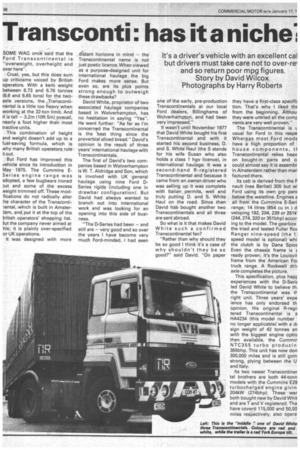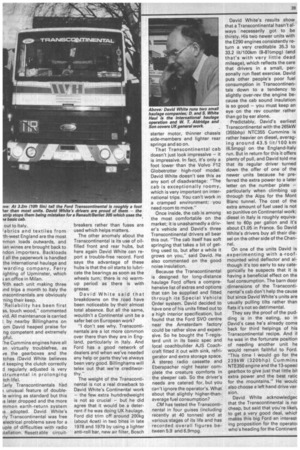Transconti : has it a nichel
Page 40

Page 41

If you've noticed an error in this article please click here to report it so we can fix it.
It's a driver's vehicle with an excellent cal but drivers must take care not to over-re, and so return poor mpg figures. Story by David Wilcox Photographs by Harry Roberts
SOME WAG once said that the Ford Transcontinental is "overweight, overheight and over here".
Cruel, yes, but this does sum up criticisms voiced by British operators. With a kerb weight between 6.73 and 6.76 tonnes (6-6 and 6.65 tons) for the twoaxle versions, the Transcontinental is a little too heavy when working at the 32-ton limit. And it is tall — 3.2m (10ft Sin) overall, nearly a foot higher than most tractive units.
This combination of height and weight doesn't add up to a fuel-saving formula, which is ,Nhy many British operators rule it out.
But Ford has improved this vehicle since its introduction in May 1975. The Cummins ESeries engine range was adopted, a few bugbears ironed out and some of the excess Neight trimmed off. These modfications do not radically alter :he character of the TransContiiental, which is built in Amsterdam, and put it at the top of the 3ritish operators' shopping list. 3ut the company never aimed at his; it is plainly over-specified or UK operations.
It was designed with more distant horizons in mind — the Transcontinental name is not just poetic licence. When viewed as a purpose-designed unit for international haulage the big Ford makes more sense. But even so, are its plus points strong enough to outweigh these drawbacks?
David White, proprietor of two associated haulage companies based in Wolverhampton, has no hesitation in saying "Yes". He went further: "As far as I'm concerned the Transcontinental is the 'best thing since the proverbial sliced bread." David's opinion is the result of three years' international haulage with Transcontinentals.
The first of David's two companies based in Wolverhampton is W. T. Aldridge and Son, which is involved with UK general haulage using nine Ford DSeries rigids (including one in drawbar configuration). But David had always wanted to branch out into international work and was looking for an opening into this side of business.
"The D-Series had been — and still are — very good and so over the years I have become very much Ford-minded. I had seen one of the early, pre-production Transcontinentals at our local Ford dealers, Billinghams of Wolverhampton, and had been very impressed."
It wasn't until November 1977 that David White bought his first Transcontinental and with it started his second business, D. and S. White Haul (the S stands for his wife Susan who also holds a class 1 hgv licence), in international haulage. It was a second-hand R-registered Transcontinental and because it came from an owner-driver who was selling up it was complete with Italian permits, well and truly putting D. and S. White Haul on the road. Since then David has bought another two Transcontinentals and all three are sent abroad.
So what is it that makes David White such a confirmed Transcontinental fan?
"Rather than why should they be so good I think it's a case of why shouldn't they be so good?" said David. "On paper they have a first-class specifi( tion. That's why I liked thE from the beginning. Althou they were untried all the comp nents are very well proven."
The Transcontinental is L usual for Ford in this respe Whereas most Ford moth have a high proportion of house components, tl Transcontinental relies heav on bought-in parts and o could almost say it is assembl in Amsterdam rather than mar factured there.
Its cab is derived from the F nault (nee Berliet) 305 but wi Ford using its own grp pan( below the waistline. Engines a all from the Cummins E-Seri range; 14 litres (854 cu in ) d veloping 182, 204, 239 or 261k' (244, 274, 320 or 351bhp) accor ing to the model, The gearbox the tried and tested Fuller Roz Ranger nine-speed (the 1: speed model is optional) whi the clutch is by Dana Spice Even the chassis frame is C ready proven; it's the Louisvil frame from the American Fol truck range. A Rockwell dri‘ axle completes the picture.
This specification, plus hapr experiences with the D-SeriE led David White to believe th, the Transcontinental was if right unit. Three years' expe ience has only endorsed th opinion. His original R-regi: tered Transcontinental is a HA4234 (this model number no longer applicable) with a d( sign weight of 42 tonnes an with the biggest engine optio then available, the Cummir NTC355 turbo producin 355bhp. This unit has now don 300,000 miles and is still gain strong, plying between the U and Italy.
Its two newer Transcontiner tal brothers are both 44-tonn models with the Cummins E29 turbocharged engine givin 204kW (274bhp). These wer both bought new by David Whit and are T and V registered. The have coverd 115,000 and 50,00 miles respectively, also opera out to Italy.
'abrics and textiles from .th-west England are the most nmon loads outwards, and ian wines are brought back to ndon importers. Backloads I all the paperwork is handled the international haulage and • warding company, Ferry ,ighting of Upminster, which ; an office in Milan.
Nith each unit making three Ind trips a month to Italy the inscontinentals are obviously • fling their keep.
'Reliability has been first ss, touch wood," commented vid. All maintenance is carried t by nearby Billinghams on om David heaped praise for ng competent and extremely pful.
The Cummins engines have all an virtually troublefree, as ve the gearboxes and the tches (David White believes it keeping the clutch correctly d regularly adjusted is very itrumental in prolonging tch life).
Early Transcontinentals had
unusual feature of doublele wiring as standard but this Is later dropped and the more mmon earth-return system is adopted. David White's rly Transcontinental was free electrical problems save for a uple of difficulties with radio ;tallation. Resett able circuit
breakers rather than fuses are used which helps matters.
The other anomaly about the Transcontinental is its use of oilfilled front and rear hubs, but here again David White can report a trouble-free record. Ford says the advantage of these hubs is that the oil starts to lubricate the bearings as soon as the wheels turn; there is no warmup period as there is with grease.
David White said that breakdowns on the road have been noticeable by their almost total absence. But all the same, wouldn't a Continental unit be a safer bet on European work?
"I don't see why. Transcontinentals are a lot more common over there than they are in England, particularly in Italy. And Ford has a good network of dealers and when we've needed any help or parts they've always been very good. Billinghams will telex out that we're creditworthy."
The weight of the Transcontinental is not a real drawback to David White's Continental work — the few extra hundredweight is not so crucial — but he did agree that it would be a deterrent if he was doing UK haulage. Ford did trim off around 200kg (about 4cwt) in two bites in late 1978 and 1979 by using a lighter anti-roll bar, new air filter, Bosch starter motor, thinner chassis side-members and lighter rear springs and so on.
That Transcontinental cab doesn't just look impressive — it is impressive. In fact, it's only a foot lower than the Volvo F12 Globetrotter high-roof model. David White doesn't see this as any sort of disadvantage: "The cab is exceptionally roomy, which is very important on international trips. You can't work in a cramped environment; you need room to move."
Once inside, the cab is among the most comfortable on the market; it is unashamedly a driver's vehicle and David's three Transcontinental drivers all bear this out. "The cab itself has soft springing that takes a bit of getting used to, but after a while it grows on you," said David. He also commented on the good noise insulation.
Because the Transcontinental is designed for long-distance haulage Ford offers a comprehensive list of extras and options that can be supplied and fitted through its Special Vehicle Order system. David decided to have one of his units fitted out to a high interior specification, but found that the Ford SVO centre near the Amsterdam factory could be rather slow and expensive. So he bought the T-registerd unit in its basic spec and local coachbuilder AJS Coachcraft fitted it out with sink, refrigerator and extra storage space. A stereo radio cassette and Eberspacher night heater complete the creature comforts in the sleeper cab. So the driver's needs are catered for, but you can't ignore the operator's. What about that slightly higher-thanaverage fuel consumption?
CM has tested the Transcontinental in four guises (including recently at 40 tonnes) and at various stages of its life and has recorded overall figures between 5.9 and 6.9mpg. David White's results show that a Transcontinental hasn't always necessarily got to be thirsty. His two newer units with the E290 engines consistently return a very creditable 35.3 to 33.2 lit/100km (8-81/2mpg) (and that's with very little dead mileage), which reflects the care that drivers in a small, personally run fleet exercise. David puts other people's poor fuel consumption in Transcontinentals down to a tendency to slightly over-rev the engine because the cab sound insulation is so good — you must keep an eye on the rev counter rather than gizi by ear alone.
Predictably, David's earliest Transcontinental with the 265kW (355bhp) NTC355 Cummins is rather heavier on diesel, averaging around 43.5 lit/1 00 km (6.5mpg) on the England-Italy run. But in return for this it offers plenty of pull, and David told me that its regular driver turned down the offer of one of the newer units because he preferred the extra power to a later letter on the number plate — particularly when climbing up through the Alps for the Mont Blanc tunnel. The cost of the extra amount of fuel used is not so punitive on Continental work; diesel in Italy is roughly equivalent to 60p per gallon and it's about £1 .05 in France. So David White's drivers buy all their diesel on the other side of the Channel.
On one of the units David is experimenting with a -roofmounted wind deflector and although it's too early to say categorically he suspects that it is having a beneficial effect on the fuel consumption. The barn door dimensions of the Transcontinental's cab don't help the cause but since David White's units are usually pulling tilts rather than flats it's not so detrimental.
They say the proof of the pudding is in the eating, so in David's case he's already come back for third helpings of his Transcontinental recipe. And if he was in the fortunate position of needing another unit he would remain faithful to Ford. "This time I would go for the 239kW (320bhp) Cummins NTE350 engine and the 13-speed gearbox to give just that little bil extra power and the best ratic for the mountains." He woulc also choose a left hand drive version.
David White acknowledgec that the Transcontinental is noi cheap, but said that you're likel), to get a very good deal, which makes this big Ford an interest, ing proposition for the operatoi who's heading for the Continent












































































































